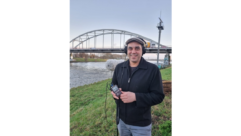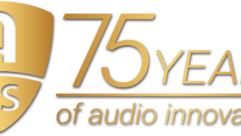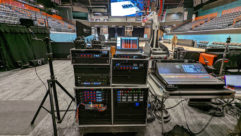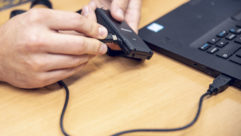collecting sound
Apr 1, 1999 12:00 PM,
Bruce Bartlett
A mic is a transducer, a device that changes one form of energy intoanother. Specifically, a mic changes sound into an electrical signal. A miccan be grouped into three types depending on its specific process forconverting sound to electricity-dynamic, ribbon or condenser. A dynamic miccapsule, or transducer, is shown in Figure 1 along with condenser andribbon mics. In a dynamic mic, a coil of wire attached to a diaphragm issuspended in a magnetic field. When sound waves vibrate the diaphragm, thecoil vibrates in the magnetic field and generates an electrical signalsimilar to the incoming sound wave. Another name for a dynamic mic is amoving-coil mic, but this term is seldom used. Dynamic mics tend to haverougher, although quite usable, responses. They are rugged and reliable,tolerate heat, cold and high humidity and can handle high volume withoutdistortion. Dynamics are preferred for guitar amps and drums, and thosewith a flat response can take the edge off woodwind and brass instruments.
In a ribbon mic capsule, a thin metal foil or ribbon is suspended in amagnetic field. Sound waves vibrate the ribbon in the field and generate anelectrical signal. Ribbon mics are generally prized for their warm, smoothtone quality, but they can be rather delicate. The element is a piece ofsuspended metal film that can be easily damaged.
A condenser or capacitor mic capsule has a conductive diaphragm and a metalbackplate placed close together, both of which are charged with staticelectricity to form two plates of a capacitor. When sound waves strike thediaphragm, it vibrates, which varies the spacing between the plates. Inturn, this varies the capacitance and generates a signal similar to theincoming sound wave. Two types of condenser mics are the true condenser andelectret condenser. In a true condenser mic (externally biased mic), thediaphragm and backplate are charged with a voltage from a circuit builtinto the mic. In an electret condenser mic, the diaphragm and backplate arecharged by an electret material in the diaphragm or on the backplate.Electrets and true condensers can sound equally good, although someengineers prefer the more costly true condensers. Condenser mics usuallyfeature wide, smooth frequency response with detailed sound and extendedhighs, and omnidirectionals have excellent low-frequency response.Transient attacks sound sharp and clear, and the condenser mic is oftenpreferred for acoustic instruments and cymbals. Because of its lowerdiaphragm mass and higher damping, a condenser mic responds faster than adynamic mic to rapidly changing sound waves (transients). This mic can alsobe miniaturized.
A condenser mic needs a power supply to operate, such as a battery orphantom power supply. Phantom power is 12 VDC to 48 VDC applied to pins 2and 3 of the mic connector through two equal resistors. The mic receivesphantom power and sends audio signals on the same two conductors. Manymixing consoles supply phantom power at their mic input connectors. Simplyplug the mic into the mixer to power it.
Dynamics and ribbons, however, need no power supply. You can plug thesetypes of mics into a phantom supply without damage, unless either signalconductor is accidentally shorted to the mic housing.
Admittedly, there are exceptions to a given mic type’s general tendencies.Some dynamics have a smooth, wide-range frequency response. Some condensersare rugged and handle high SPLs. Specs of the particular mic are variable,even within a given mic type.
Polar patternMics also differ in the way they respond to sounds coming from differentdirections. An omnidirectional mic is equally sensitive to sounds arrivingfrom all directions. A unidirectional mic is most sensitive to soundarriving from one direction-in front of the mic-and softens sounds enteringthe sides or rear of the mic. A bidirectional mic is most sensitive tosounds arriving from two directions-in front of and behind the mic-butrejects sounds entering from the sides. Figure 2 shows various polarpatterns. A mic’s polar pattern is a graph of its sensitivity vs. the angleat which sound comes into it drawn on polar graph paper. Sensitivity isplotted as distance from the origin.
There are three types of unidirectional patterns-cardioid, supercardioidand hypercardioid. A mic with a cardioid pattern is sensitive to soundsarriving from a broad angle in front of the mic. It is about 6 dB lesssensitive at the sides and about 15 dB to 25 dB less sensitive in the rear.The supercardioid pattern is 8.7 dB less sensitive at the sides and has twoareas of least pick up at 125degrees away from the front. The hypercardioidpattern is 12 dB less sensitive at the sides and has two areas of leastpick up at 110degrees away from the front. The supercardioid andhypercardioid reject sound from the sides more than the cardioid, but theypick up more sound from the rear than the cardioid.
Omnidirectional mics feature all-around pick up, and consequently, theypick up the most room reverberation. They do not offer much isolationunless you mic close. They have a low sensitivity to pop (explosive breathsounds) and a low handling noise. With an omnidrectional mic, there is noup-close bass boost (proximity effect). An extended low-frequency responsein condenser omnis makes them great for the pipe organ or bass drum in anorchestra or symphonic band. Generally lower in cost, they are acceptablewhen feedback is not a problem.
Unidirectional mics (cardioid, super-cardioid and hypercardioid), on theother hand, have selective pickup and reject room acoustics, backgroundnoise and leakage. Their good isolation yields a high degree of separationbetween instruments, and they feature up-close bass boost, except in micswith holes in their handles. They provide better gain-before-feedback in asound-reinforcement system and have coincident or near-coincident stereomicing.
Cardioid, supercardioid and hyper-cardioid polar patterns are somewhatsimilar. Cardioids support a broad-angle pickup of sources in front of themic with maximum rejection of sound approaching the rear of the mic.Super-cardioids, however, provide the maximum difference between front- andrear-hemisphere pickup (good for stage-floor applications), with moreisolation than a cardioid and less reverb pickup. Hypercardioids havemaximum side rejection in a unidirectional mic, with maximum isolation andmaximum rejection of reverberation, leakage, feedback and background noise.
Bidirectional mics allow front and rear pickup with side sounds rejected,which is useful for across-table interviews or two-part vocal groups. Thesemics allow maximum isolation of an orchestral section when placed overheadand can perform Blumlein stereo micing (two bidirectional mics crossed at90degrees). They are seldom used in installed sound.
A good mic’s polar pattern should be about the same from 200 Hz to 10 kHz.Otherwise, you will hear off-axis coloration; the mic will have a differenttone quality on and off axis. Small-diaphragm mics tend to have lessoff-axis coloration than large-diaphragm mics.
Frequency responseAs with other audio components, a mic’s frequency response is the range offrequencies that it will reproduce at an equal level (within a tolerance,such as +/-3 dB). The mic frequency response that is adequate to reproducethe source with high fidelity is 80 Hz to 15 kHz for most musicalinstruments, 40 Hz to 9 kHz for bass instruments, 80 Hz to 12 kHz for brassinstruments and voice, and 40 Hz to 15 kHz for an orchestra or symphonicband. A wider-range response works, too.
If possible, use a mic with a response that rolls off below the lowestfundamental frequency of the sound source. For example, the frequency ofthe low E-string on an acoustic guitar is about 82 Hz. A mic used on theacoustic guitar should roll off below that frequency to avoid picking upsuch low-frequency noise as rumble from trucks. Some mics have an integrallow-cut switch for this purpose, or you can filter out the unneeded lows atthe mixer.
A frequency-response curve is a graph of the mic’s output level in decibelsat various frequencies. The output level at 1 kHz is placed at the 0 dBline on the graph, and the levels at other frequencies are so many decibelsabove or below that reference level. The shape of the response curvesuggests how the mic sounds at a certain distance from the sound source. Ifthe distance is not specified, it is probably 2 feet to 3 feet (610 mm to914 mm). For example, a mic with a wide, flat response reproduces thefundamental frequencies and harmonics in the same proportion as the soundsource, so a flat-response mic tends to provide accurate, naturalreproduction at that distance. Note that mic placement can greatly affectthe recorded tone quality. A flat-response mic does not always guarantee anatural sound because mic placement has such a strong influence.
A rising high end or a presence peak around 5 kHz to 10 kHz sounds morecrisp and articulate because it emphasizes the higher harmonics (see Figure3). Sometimes this type of response is called tailored or contoured. It ispopular for guitar amps and drums because it adds punch and emphasizesattack. Some mics have switches that alter the frequency response.
Most unidirectional and bidirectional mics boost the bass when used withina few inches of a sound source. You may have heard how the sound gets bassywhen a vocalist sings right into the mic. This low-frequency boost relatedto close mic placement is called the proximity effect, and it is oftenplotted on the frequency-response graph. Omni mics have no proximityeffect; they have the same tonal balance at any distance.
The warmth created by proximity effect adds fullness to drums. In mostsituations, however, the proximity effect lends an unnatural boomy or bassysound to the instrument or voice the mic picks up. Some mics-multiple-D orvariable-D types-are designed to reduce this low-frequency boost. Thesetypes have holes or slots in the mic handle. Some mics have a bass-rolloffswitch to compensate for the bass boost, or you can roll off the excessbass with the mixer’s EQ until the sound is natural. By doing so, you willalso reduce any low-frequency leakage the mic picks up.
Other specsImpedance is the mic’s effective output resistance at 1 kHz. A micimpedance between 150 V and 600 V is low; 1,000 V to 4,000 V is medium, andabove 25 kV is high. Almost all mics these days are low impedance, whichlets you run long mic cables without picking up hum or losing highfrequencies. The input impedance of a mixer mic input is about 1,500 V. Ifit were the same impedance as the mic, about 250 V, the mic would load downwhen pluged in, which could result in loss of level, distortion or a thinsound. To prevent this, a mic input has an impedance much higher than thatof the mic, typically 1,500 V, but it is still considered a low-Z input.
Another important spec is maximum SPL (sound pressure level), and if it is125 dB SPL, then the mic starts to distort when the sound source generates125 dB SPL at the mic. A maximum SPL spec of 120 dB is good; 135 dB issuperior, and 150 dB is excellent. Dynamic mics tend not to distort, evenwith loud sounds. Some condensers are just as good, and some have a pad youcan switch in to prevent distortion in the mic circuitry. Because a mic padreduces S/N ratio, use it only if the mic distorts.
Sensitivity tells how much output voltage a mic produces when driven by acertain SPL. A high-sensitivity mic generates a stronger signal (highervoltage) than a low-sensitivity mic when both are exposed to an equallyloud sound. Typical sensitivity specs for three transducer types are 5.6mV/Pa (high sensitivity) for condensers, 1.8 mV/Pa (medium sensitivity) fordynamics and 1.1 mV/Pa (low sensitivity) for ribbons or small dynamics. Thelouder the sound source, the higher the signal voltage the mic puts out. Alouder instrument, such as a kick drum or guitar amp, can cause a mic togenerate a signal strong enough to overload a mixer’s mic preamp, which iswhy most mixers have pads or input-gain controls.
Self-noise or equivalent noise level is the electrical noise or hiss a micproduces. It is the dB SPL of a sound source that would produce the sameoutput voltage that the noise does. Usually, the self-noise spec isA-weighted-the noise was measured through a filter that makes themeasurement correlate more closely with the annoyance value. The filterrolls off low and high frequencies to simulate the frequency response ofthe ear. An A-weighted self-noise of 18 dB SPL or less is excellent(quiet); around 28 dB SPL is good, and around 35 dB SPL is fair. Because adynamic mic has no active electronics to generate noise, it has lowself-noise (hiss), so most spec sheets for dynamic mics do not specifyself-noise.
The S/N ratio is the difference in decibels between the mic’s sensitivityand its self-noise. The higher the SPL of the sound source at the mic, thehigher the S/N ratio. Given an SPL of 94 dB, an S/N ratio of 74 dB isexcellent; 64 dB is good.
The higher the S/N ratio, the cleaner the signal and the greater is thereach of the mic. Reach is the clear pickup of quiet, distant sounds due toa high S/N ratio. Reach is not specified in data sheets because any mic canpick up a source at any distance if the source is loud enough.
Output level can be mic level or line level. Most mics have a mic-leveloutput (roughly 2 mV), but some have built-in preamps to provide aline-level output (about 1.4 V). They can be plugged directly into VCRs forsuch applications as security recordings.
Boundary micsConventional mics are designed to be placed on mic stands, held in the handor hung from the ceiling. Boundary mics are designed to be used onsurfaces. Such mics are often placed on conference tables, taped underpiano lids or mounted on stage floors. A boundary mic uses a mini condensermic capsule mounted near a sound-reflecting plate or boundary. Because ofthis construction, the mic picks up direct sound and reflected sound at thesame time-in-phase at all frequencies-so you get a smooth response that isfree of phase cancellations. A conventional mic near a surface soundscolored; a boundary mic on a surface sounds natural.
Unidirectional boundary mics have a half-cardioid or half-supercardioidpolar pattern. They work well on a conference table or near the front edgeof a stage floor to pick up drama or musicals. Some conference mics of thisdesign have elegant styling and push-to-talk switches. Miniature,unidirectional boundary mics are no bigger than a silver dollar. Theelectronics for these mics is in a separate chassis under the table.
Theater stageHaving established a good foundation of mic knowledge, we will now considervarious fixed-installation applications. Plays and musicals in anauditorium are a challenge to pick up and amplify well. First, try to solvethe problem at its source. The director should ask the performers to speakloudly and clearly. If the music drowns out the actors, tactfully ask themusical director to have the pit orchestra play more quietly. Good mics canhelp, too. Three types of mics are used for stage applications: floor mics,hanging mics and miniature wireless mics.
For floor mics, omnidirectional boundary mics work well for area pickup ofactors. Such mics are rugged enough to withstand kicks by dancers and canbe stepped on without damage. Placed on the stage floor near thefootlights, they are almost invisible. You might wonder if the mics pick upfootsteps because they are on the floor. Unidirectional boundary mics arenot sensitive to floor vibrations, but, like your ears, they do hearfootsteps acoustically. This is normally not a problem because the audienceassociates the sound with the actors walking across the stage. Because oftheir cardioid or supercardioid polar pattern, floor mics reduce feedbackand attenuate the pit orchestra. Typically, space three floor mics evenlynear the edge of the stage (see Figure 4). Place them as closely aspossible toward the actors. One or two mics might be enough for a smallstage.
The more mics that are on, the muddier the sound, and the poorer the gainbefore feedback will be. To aid clarity and reduce feedback, have the soundperson turn up as few mics as possible. For example, suppose an actor walksacross the stage from left to right while talking. The left mic should beturned up first, then turned down while turning up the center mic. Next,the center mic sould be turned down while turning up the right mic. Thesound mixer should follow cues in the script to know when to turn variousmics up and down.
Hanging mics are sometimes used because of the limitations of floor mics,which can typically reach about 20 feet (6.1 m). If it is hard to hearactors farther upstage, hang one to three mini cardioid mics upstage ortape omnidirectional boundary mics to the set.
The preferred way to pick up the main actors on stage is with lavalierwireless mics. You can clip a miniature omnidirectional mic on clothing orhang it over the actor’s forehead with the cable running through the hair.To prevent sweat damage, you might want to cover the mic in a thin plasticsandwich bag or plastic wrap. The plastic should be loose, not stretchedtaut. Wire on the appropriate connector, and plug the mic into a belt-packtransmitter of your choice.
Because the mic is close to the actor, the sound will be louder and clearerthan with a floor mic. If the budget permits, use mini wireless mics forthe main actors and floor mics for group pickup. Adjust the audio trim potin each transmitter as high as possible without distortion when the actoris yelling.
Lecterns and pulpitsTwo ways to pick up speeches at a lectern are with a gooseneck mic or witha clip-on mini mic (lavalier). Current gooseneck mics have a slim, elegantdesign that does not detract from the person speaking. The goosenecksadjust without creaking. Some models plug into a female XLR-type chassismount connector in the lectern; others have circuit modules with screwterminal connectors. Need extra ruggedness? One model has a ball-and-socketswivel instead of a gooseneck. The swivel operates silently.
Have users talk about 8 inches (203 mm) away and over the mic to preventbreath pops. Consider using a lectern-mounted shock mount to reduce lecternthumps. Some lectern mics have an internal shock mount.If the person talking wanders around while speaking, a miniatureomnidirectional mic will need to be clipped to his clothing. Do not havethe gooseneck mic and the lavalier mic on at the same time, or combfiltering will be audible.
Conferences and teleconferencesSuppose the client needs to pick up speech at a conference table. A simplemic setup that works well for recording is a single omnidirectionalboundary mic on the table top at the center of every eight people. Thismic, however, will pick up more room acoustics and speaker feedback thanindividual closeup mics. You may need to use several unidirectionalboundary mics. Place one mic near each person, or one mic between every twopeople, an arm’s length away.
Some of these mics come with push-to-talk switches so that users cancontrol their own mics. These mics are run into a standard mic mixer. Ifthe mics have no switches, the mixer should be automatic or gated. Whensomeone speaks into a mic, the mixer turns on that mic and turns off allthe other mics. By reducing the number of open mics, this gating makes thesound clearer and reduces feedback. Automatic mixers also have suchfeatures as chairperson override and number-of-open-mics (NOM)compensation. Some conference mics include three or four unidirectionalboundary mic capsules in a single housing; simply place the mic in themiddle of the table.
Distance learningIn this application, the teacher wears a clip-on mic. Each student or pairof students has a desk mic. Students can switch on their mics when theywant to ask the teacher a question. The desktop mic can be a unidirectionalboundary mic or gooseneck. If there are no desks, goosenecks or switchableboundary mics can be mounted on the backs of seats. You can also hang micsabout 8 feet apart and 8 feet (2.4 m) overhead. Angle the mics 45degreesdownward to reject the loudspeaker in the front of the room (see Figure 5),and run the mics through an automatic mixer.
CourtroomIn courtroom installation (see Figure 6), the judge should be miced bymounting a gooseneck or a unidirectional boundary mic on the judicialbench. If you want this mic to pick up both the judge and people standingat the bench, use an omnidirectional boundary mic.
If the lawyers wander around while speaking, have them clip a lavalier micto their clothing about 8 inches (203 mm) under the chin. You might preferto go wireless. If the lawyers speak mostly from a table, place aunidirectional boundary mic on their tables.
For the witnesses, install a lectern mic, ideally with a foam windscreen toreduce breath pops. A typical mic distance is 8 inches (203 mm) from themouth.
Hang a mini cardioid mic over and in front of the jury. Place the mic 18inches in front of the front row and 18 inches (457 mm) over thehead-height of the back row. If you prefer a mic stand, use a handheldcardioid mic, or mount a unidirectional boundary mic on the short wall infront of the jury.
Athletic eventsThese events require a mic that picks up the announcer without picking upthe crowd noise. A noise-cancelling or differential mic does the job.Because it cancels sounds a few inches away, this mic must be used withlips very near, or touching, the mic. A common mic to use here is aheadworn mic. Some are designed with the mic directly in front of the mouthfor maximum isolation. Models that mount the mic at the side of the mouthsound more natural. Some announcers prefer to use a handheld mic with afoam windscreen. This mic can be either a cardioid dynamic type or acondenser differential type.
Houses of worshipIn this application (as in others) we want to hear the words loudly andclearly and hear music reproduced with full fidelity. Here are somesuggestions. For the minister, refer to the tips about lectern or pulpitmicing.
Some mics are specially designed for hanging over a choir; these mics arealmost invisible and sound natural. Use one mic in the center of every 20foot (6.1 m) to 30 foot (9.1 m) span. A choir of 30 to 45 voices shouldneed only two or three mics.
If the choir mics are used for sound reinforcement, place them close to thechoir to minimize feedback-about 18 inches (457 mm) in front of the frontrow of singers and about 18 inches above the head height of the back row(see Figure 7). If the mics are used only for recording or broadcast, placethem about 10 feet (3 m) to 20 feet (6.1 m) away to pick up the acousticsof the sanctuary.
In some venues, hanging mics is inconvenient. Try placing them on micstands. Extend the stands to full height, and aim the mics up at the choir.As an alternative, make the mic stands taller by adding baby booms, and aimthe mics down at the choir. Some churches make mic stands of clear Lexan toreduce visibility.
For the baptismal, hang a miniature choir mic overhead, or mount anomnidirectional boundary mic inside on the glass (see Figure 8). If thebaptismal is shallow, you can use a wireless lavalier mic because iteliminates the electrical hazard of dropping a mic into the water. Thewireless mic uses a battery of up to 9 V and thus poses no risk of shock.
You will not need to mic the organ for sound reinforcement, but you mightneed to do so for recording or broadcast. Omni condenser mics arerecommended because they reproduce the low notes with richness and depth.Hang one or two mics 10 feet (3 m) to 20 feet (6.1 m) from the organ pipesor organ loudspeaker, 3 feet (914 mm) apart for stereo.
If the guitarist uses a pickup, connect its phone plug to a direct box. Setthe ground-lift switch on the direct box to the position that produces theleast hum (probably not lifted). There are also several ways to mic theguitar. One is to tape a mini omnidirectional mic onto the guitar bodyhalfway between the sound hole and the bridge (see Figure 9). Anothermethod is to place a cardioid condenser mic about 6 inches (152 mm) fromwhere the fingerboard meets the guitar body, and aim the mic toward thesound hole.
With a grand piano, tape two omnidirectional boundary mics to the undersideof the raised lid, one over the treble strings and one over the bassstrings (see Figure 10), or use two cardioid condensers about 8 inches (203mm) above the hammers and 8 inches horizontally from the hammers. Iffeedback is a problem, close the lid and adjust the mixer EQ (tonecontrols) until the sound is natural. You will typically need to cut a fewdecibels around 250 Hz to reduce boominess. An upright piano needs twocardioids a few feet apart near the soundboard.
Other specific applications have relatively simple solutions. A soloist orreader can be covered with a stand-mounted handheld mic. Be sure to place afoam pop filter (windscreen) on the mic to prevent breath pops. Use a babyboom on a mic stand to reach a person seated in a presider’s chair. For thesinger, the choice is a cardioid handheld mic, either condenser, dynamic orribbon. It can be wired or wireless. Try a unidirectional boundary mic onthe floor near the bench for the predue (kneeling bench for weddings). Forthe altar table, place a unidirectional boundary mic on the table aiming atthe people speaking. Some mic models are available in white to blend with awhite tablecloth. You may need to mic the congregation for recording orbroadcast. To do so, hang one or two mini cardioid mics several feet overthe front row of the congregation, aiming toward the rear of the hall.
Paging, security and surveillanceThe usual type of mic for paging applications is an omnidirectional dynamicon a gooseneck with a built-in switch. Another choice is a condenser typewith a slim gooseneck and a push-to-talk switch in the base.
For security and surveillance, however, most mics are boundary types thatinstall in an electrical outlet box, wall or ceiling. Some are designed notto look like mics so that they are nearly invisible. Look for a mic thatfilters out the lows to reduce rumble and boosts the highs for articulation.
One way to cover a large room is with omnidirectional boundary mics on theceiling. Use the 2 to 1 rule for even coverage. The spacing between micsshould be twice the distance from mouth to ceiling. For example, if theceiling is 5 feet (1.5 m) above the talkers’ mouths, the mics should be 10feet (3 m) apart. Then, the mics will pick up everyone about equally.
In general, use as few mics as possible that will do the job. Remember thatif several mics are on simultaneously, the sound might be reverberant ormuddy. It helps to run all the mics into a gated mixer (automatic mixer),which keeps the sound clear. If the ceiling is high, mount the mics onsupport posts or walls about 10 feet (3 m) off the floor (out of reach).Medium-sized rooms are best covered with an omnirectional boundary mic onthe ceiling near the middle of the room.
For a police interview room or psychiatrist’s office, mount anomnidirectional boundary mic in the ceiling directly over the interviewtable. Another placement is in a wall close to the table at mouth height.If possible, deaden the room acoustics by adding curtains, carpet oracoustic-tile ceiling. This reduces room reverb, yielding a clearer sound.
Mount omnidirectional boundary mics in posts, in the ceiling or in wallsfor subway stations. Place the mics 10 feet (3 m) above the floor and outof reach. If the mics will be 10 feet from people on the average, mount themics 20 feet (6.1 m) apart to pick up everyone about equally. That is, themics should be no more than twice as far apart as they are from the people.
For points of entry, mount an omnidirectional boundary mic in an overhang,or mount a unidirectional boundary mic aiming down over the entry. It isbest not to expose the mic to rainfall.
FeedbackHere are some suggestions for reducing the likelihood of feedback in anyapplication: use as few mics as possible; keep loudspeakers and mics as farapart as is practical; and place speakers behind mics. Turn down mics notin use. Keep mics as close to their sound sources, but no closer thannecessary to achieve enough volume before feedback occurs. Finally, usedirectional mics-cardioid, supercardioid, or hypercardioid.
Mics are an integral part of many fixed installations. Familiarization withbasic mic characteristics is a large step toward a smooth project.Determining the proper mic for a given application is crucial; it can averta multitude of unnecessary hassles. Follow the tips in this guide, and lookforward to better sound in your installations. Your clients will thank you.










